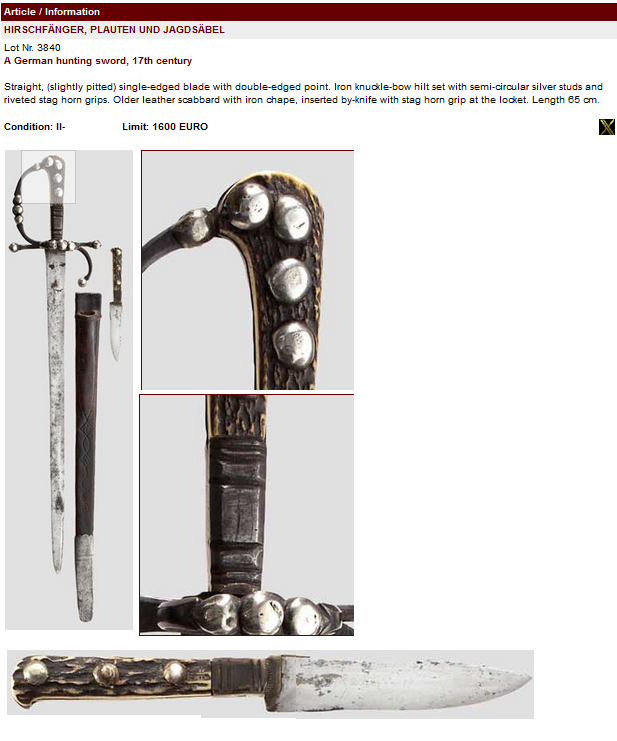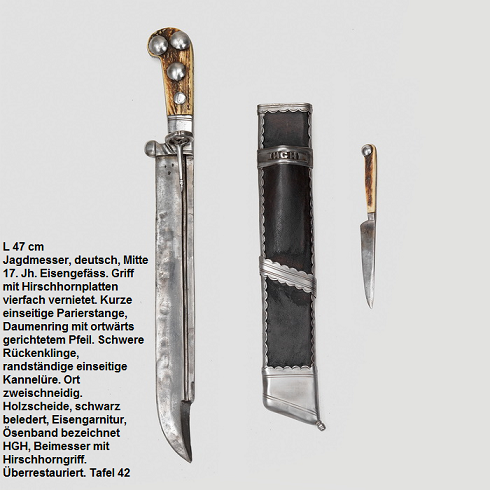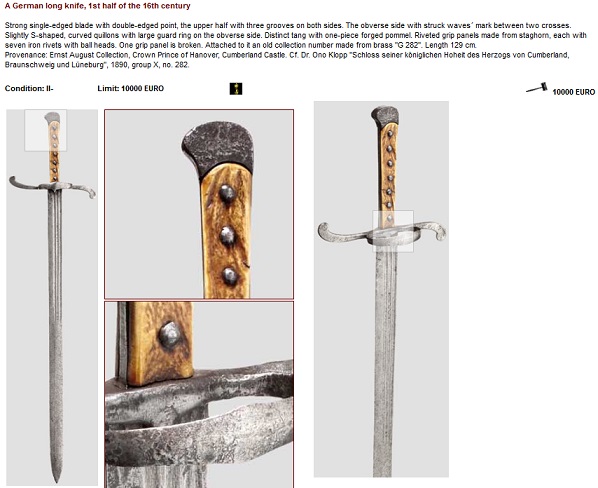| Author |
Message |
J. Nicolaysen

|
 Posted: Thu 08 May, 2014 6:47 am Post subject: Elk antler handle Posted: Thu 08 May, 2014 6:47 am Post subject: Elk antler handle |
 |
|
Hello,
So I have a elk antler laying around. Rocky Mountain elk (wapiti) for those who weirdly think I'm talking about a moose. 
He was a 6x5 from five years ago, my first elk. The six point branch was made into a nice tabletop candle-holder by a friend who died recently. The other branch had the sixth point broken, perhaps in a battle, or just on a tree. I had shotgun chaps made from the hide.
Anyhoo, I'd like to start to put the broken branch into knife and sword handles. It's been hanging in the garage with no other treatment. Seems like I have the spread of bronze-age to Migration-era handles as possibilities, and even bauernwehr or knife handles from much more recent to choose from.
Not sure if some ear daggers have antler components, but I would like to begin a commission of one of those soon. I guess I'm wondering if I need to just ask a possible smith how much of the antler he would need, or how many handles I might be able to get out of this. And what parts of the antler might make the best portions for handles.
Also wondering if there are certain types of swords or daggers that really rely on antler handle components. Thanks for any help!
Last edited by J. Nicolaysen on Thu 08 May, 2014 6:58 am; edited 2 times in total
|
|
  |
 |
J. Nicolaysen

|
 Posted: Thu 08 May, 2014 6:53 am Post subject: Posted: Thu 08 May, 2014 6:53 am Post subject: |
 |
|
Here is the antler. About 42 inches long, six inches circumference at base.
 Attachment: 135.91 KB Attachment: 135.91 KB

Antler
|
|
  |
 |
Julien M

|
 Posted: Thu 08 May, 2014 7:00 am Post subject: Posted: Thu 08 May, 2014 7:00 am Post subject: |
 |
|
Antler brings one name to mind right away: Petr Florianek, a smith who favors antler as his grip material of choice...also a member of this forum.
I'd send him a PM.
J
|
|
  |
 |
J. Nicolaysen

|
 Posted: Thu 08 May, 2014 7:29 am Post subject: Posted: Thu 08 May, 2014 7:29 am Post subject: |
 |
|
Hi Julien, thanks for the response! Your DIY stuff is amazing.
I did buy a very nice sax from Petr and plan to do more commissions from him in the future. His carving technique and designs are amazing. I hadn't thought about his antler work since I only this year found his work.
I think I might be able to get two or three dagger handles from the antler, and perhaps some rings for a migration-type sword.
Also, in my business, I have some access to ram horn, from Rambouillet sheep. I wonder if sheep horns were ever used for hilt components?? We cut off some of the horn tips at the end to make them easier to handle for shearing, etc. Perhaps I can find a use for these. Don't worry, it doesn't hurt the sheep as we cut it well after the horn socket.
|
|
  |
 |
|
Robert Frey
Location: Wausau, WI Joined: 19 Nov 2013
Posts: 42
|
 Posted: Thu 08 May, 2014 9:35 pm Post subject: Posted: Thu 08 May, 2014 9:35 pm Post subject: |
 |
|
| J. Nicolaysen wrote: | | Here is the antler. About 42 inches long, six inches circumference at base. |
I guess I see two handles, the crotch and the crown.
But I'm no expert.
|
|
  |
 |
|
Radovan Geist
|
 Posted: Fri 09 May, 2014 12:25 am Post subject: Posted: Fri 09 May, 2014 12:25 am Post subject: |
 |
|
Hello,
hunting hangers and hunting swords from later part of 17th century use antler handle (scales from antler) quite often. I´m attaching one of more common forms (picture courtesy to Herman Historica).
Rado
 Attachment: 237.34 KB Attachment: 237.34 KB

|
|
  |
 |
|
Mark Moore
|
 Posted: Fri 09 May, 2014 3:41 am Post subject: Posted: Fri 09 May, 2014 3:41 am Post subject: |
 |
|
Being a backyard knife maker, I can tell you.......You have a whooooole bunch of handle material there. It all depends on how it is cut up and/or sliced. I could make 6 or 7 knives with that. Maybe more. The tips beg for a nice size seax blade.  ............McM ............McM
''Life is like a box of chocolates...'' --- F. Gump
|
|
  |
 |
J. Nicolaysen

|
 Posted: Fri 09 May, 2014 5:46 am Post subject: Posted: Fri 09 May, 2014 5:46 am Post subject: |
 |
|
Thanks everyone! Radovan, I have never been particularly fond of the later swords (era of baskethilt/rapiers/smallsword and beyond), but that hunting sword is fantastic. I love the matching by knife also.
I love seeing the examples of antler handles so I can think about a good project. If anyone has more I would love to see them, no matter the time period or style. I definitely think there is a seax and a hunting knife in there.
Mark, How would you suggest cutting the pieces to make the most out of it? Where the branches are first, I guess and then see how it "handles" Or maybe I need to think more of the type of knives I'd like.
Also, I expect a bandsaw is the best way to cut this? Then send some pieces to various smith/cutlers.
Finally, did anyone have an idea about the ram horn use in weapons?
|
|
  |
 |
|
Radovan Geist
|
 Posted: Fri 09 May, 2014 6:37 am Post subject: Posted: Fri 09 May, 2014 6:37 am Post subject: |
 |
|
Hello, you´re welcome:)
With cutting, I would definitely think first about the type of a knife / sword - if you need a solid piece of an antler for a seax or early medieval knife, or thin plates for grip plates.
As for the cutting tool, I usually use a hand-saw for metal (like this one http://depositphotos.com/1047759/stock-photo-Saw-on-metal.html)
I´m attaching another hunting knife of an earlier form, with a small by-knife, and a German messer with staghorn handle plates.
 Attachment: 243.3 KB Attachment: 243.3 KB

 Attachment: 74.47 KB Attachment: 74.47 KB

|
|
  |
 |
|
Niels Just Rasmussen
|
 Posted: Sun 07 Sep, 2014 7:54 am Post subject: Posted: Sun 07 Sep, 2014 7:54 am Post subject: |
 |
|
| Radovan Geist wrote: | Hello, you´re welcome:)
With cutting, I would definitely think first about the type of a knife / sword - if you need a solid piece of an antler for a seax or early medieval knife, or thin plates for grip plates.
As for the cutting tool, I usually use a hand-saw for metal (like this one http://depositphotos.com/1047759/stock-photo-Saw-on-metal.html)
I´m attaching another hunting knife of an earlier form, with a small by-knife, and a German messer with staghorn handle plates. |
So it seems in my opinion that Hirschfängers grows from ordinary “langes messers“ to become a more and more specialized deer-killer weapon with time, which off course explains symbolically why it is obvious to give it an antler hilt and why they retain a “Nagal“.
Many of the antique german Hirschfänger from 1800-1900's hundreds, you can see on the net, has antler hilts. Also the ones from WW2.
What is interesting is that the later post-1800 Hirschfängers (for hunting, not the military ones) seem to be a lot shorter than the earlier types.
Could it be the change in the kill of stags?
With “parforcejagd“ the animal is not injured when you approach it on foot, but just really tired. You need perhaps a longer blade to ensure a kill without coming to close?
With shooting you would be animal heavily and use the shorter hirschfänger as a coup de grace.
AND/OR that the earlier Hirschfängers was a combined self-defense weapon and deer-killer and with the time of hunting rifles (and smallswords) the hirschfänger was then only a deer-killer and hence shorter.
It would seem quite nuts to run around in a real forest (not the parks we mostly have today) with a rapier as your primary defense weapon. I mean wouldn't the scabbard holding a 1 meter thin blade seem like something that would get caught in everything and hinder movement??
I have to admit I never run around with a rapier........
So when hunting a hirschfänger of 50-60 cm blade length could be a combined personal / deer-killer weapon?!
|
|
  |
 |
|
|

